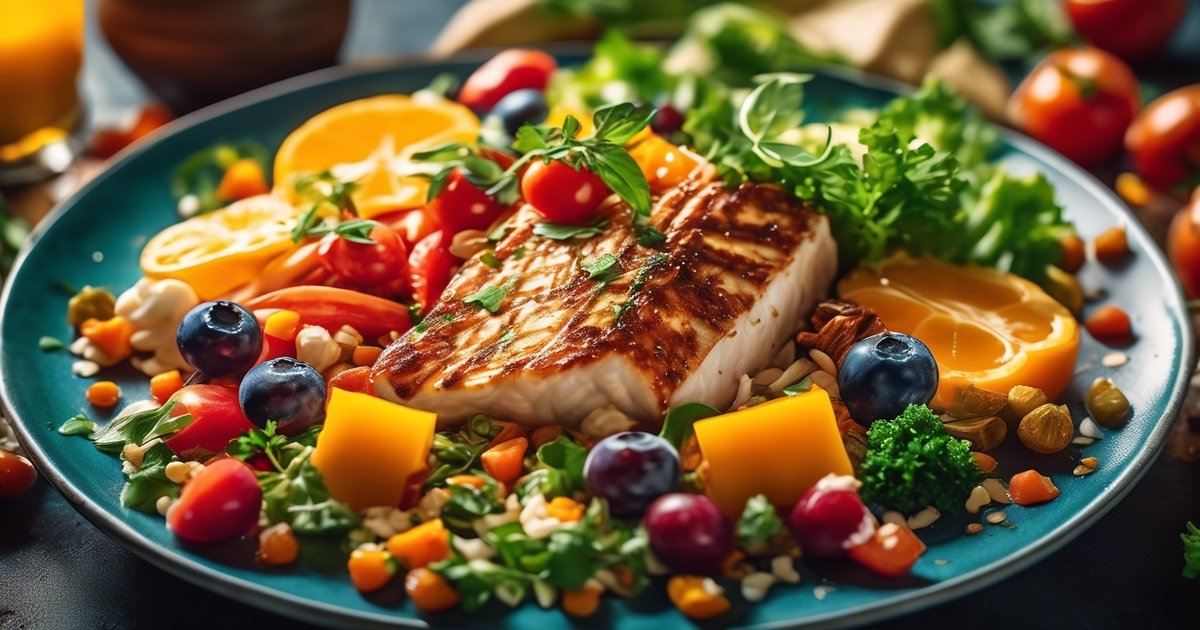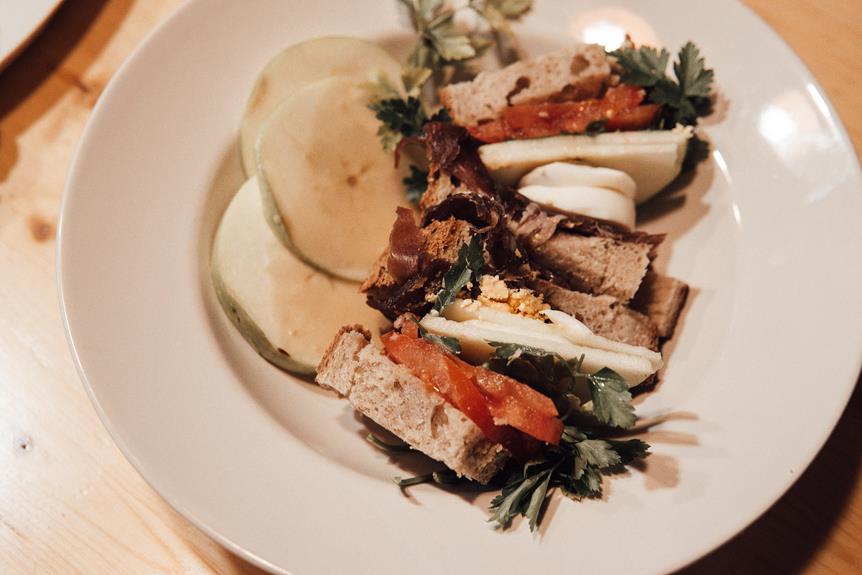How to Lose 10 Pounds in a Month Food?
DATE : 17 August 2024 By : Tareq Qteshat

To lose 10 pounds in a month, focus on creating a 500-calorie deficit through a combination of diet and exercise. Eat protein-rich foods like lean meats, fish, and plant-based options to feel full and satisfied. Incorporate healthy fats like nuts, seeds, avocados, and fatty fish to support hormone production and brain function. Prioritize whole grains, dark leafy greens, and cruciferous vegetables for their nutrient-dense properties. Choose low-fat dairy products and control portion sizes to maintain a calorie deficit. By making these informed food choices, you'll be on track to reach your weight loss goal – and there's more to explore to help you get there.
Table of Contents
ToggleKey Takeaways
- To lose 10 pounds in a month, create a calorie deficit of 500 calories per day through diet and exercise.
- Eat protein-rich foods like chicken, turkey, tofu, and fish to feel full and satisfied.
- Incorporate healthy fats like nuts, seeds, avocados, and fatty fish to support weight loss.
- Focus on whole grains, vegetables, and dark leafy greens to provide fiber and nutrients.
- Practice portion control and measure food accurately to maintain a calorie deficit and support weight loss.
Set Realistic Calorie Goals
To lose 10 pounds in a month, you'll need to create a calorie deficit of around 500 calories per day through a combination of diet and exercise. This means you'll need to consume fewer calories than your body burns, resulting in weight loss.
To achieve this, you'll need to set realistic calorie goals. Incorporating healthy recipes for picky eaters into your diet can help make the process more enjoyable.
Daily tracking is essential to understanding your calorie intake. You can use a food diary or a mobile app to track your daily food consumption. Record everything you eat and drink, including portion sizes and calorie counts. This will help you identify areas where you can cut back on calories.
Calorie counting can be tedious, but it's a vital step in setting realistic calorie goals. Aiming for low calorie meals can also help you stay on track. Aim to reduce your daily calorie intake by 250-500 calories to create a calorie deficit. You can do this by eating smaller portions, skipping unhealthy snacks, and avoiding high-calorie foods.
Eat Protein Rich Foods
Protein-rich foods play a crucial role in your weight loss journey. They help you feel full and satisfied, making it easier to stick to your calorie goals.
When you consume enough protein, you'll also build and maintain muscle mass, which further supports your weight loss efforts. Aim to include a source of protein in every meal and snack. You can try incorporating lean proteins like chicken or turkey into your meals, such as making turkey meatballs with hidden veggies Sneaky Ways to Incorporate Vegetables.
Additionally, using herbs and spices can add flavor to your protein-rich dishes instead of relying on salt and sugar.
You don't have to rely on meat to get enough protein. Meat alternatives like tofu, tempeh, and seitan are excellent options.
You can also try plant-based protein powders or protein shakes made from pea, rice, or hemp protein. If you're an animal product consumer, choose lean protein sources like poultry, fish, and low-fat dairy.
Legumes, such as lentils, chickpeas, and black beans, are also rich in protein and fiber. Experiment with different protein-rich foods to find what works best for you.
When you prioritize protein, you'll be better equipped to manage hunger and cravings, making it easier to reach your weight loss goals
Incorporate Healthy Fats
You've established a protein-rich diet, now it's time to incorporate healthy fats to support your weight loss journey. Healthy fats are essential for hormone production, brain function, and the absorption of vitamins, making them a vital component of a balanced diet.
By adding nuts and seeds, fatty fish options, and avocados to your meal plan, you'll be taking a significant step towards achieving your weight loss goal of 10 pounds in a month.
Incorporating healthy fats can also help prevent chronic diseases like obesity and diabetes, as well as improve cognitive function and concentration Healthy Eating Benefits. Additionally, healthy fats can be found in various healthy recipes, such as baked fish nuggets and cheesy beef goulash, which can be made in advance and reheated for convenience.
Nuts and Seeds
A handful of nuts and seeds can be a valuable addition to your weight loss diet, providing a concentrated source of healthy fats, fiber, and protein. Incorporating these nutrient-dense foods can help keep you full and satisfied, making it easier to stick to your weight loss plan.
When choosing nuts and seeds, opt for unsalted and unsweetened varieties to reap the most benefits.
Some nuts, like almonds and walnuts, are particularly high in healthy fats and antioxidants.
You can also reap the benefits of nut butter benefits by incorporating peanut butter or almond butter into your diet.
Spread a tablespoon or two on whole grain toast or use it as a dip for fruit.
Seeds, such as chia, flax, and hemp, are rich in omega-3 fatty acids and fiber.
You can also use seed oil, like chia seed oil or flaxseed oil, as a healthy alternative for cooking and dressings.
Aim for a daily serving of about 1 ounce, or a small handful, of nuts and seeds to support your weight loss goals and overall health.
Fatty Fish Options
Incorporating fatty fish into your diet can substantially boost your weight loss efforts and provide a wealth of nutritional benefits. Fatty fish are rich in omega-3 fatty acids, which are essential for reducing inflammation and promoting weight loss. You can find these healthy fats in fish like salmon, tuna, and mackerel.
When consumed regularly, fatty fish can help you feel full and satisfied, making it easier to stick to your weight loss diet.
If you're struggling to incorporate fatty fish into your diet, consider taking fish oil supplements. These supplements provide a concentrated dose of omega-3 fatty acids, which can help support weight loss and overall health. However, it's always best to get your nutrients from whole foods whenever possible.
Try experimenting with fatty fish recipes, such as grilled salmon or tuna salad, to add some variety to your diet. You can also find many healthy and delicious fatty fish recipes online. By incorporating fatty fish into your diet, you'll be taking a significant step towards achieving your weight loss goals and improving your overall health.
Avocado Benefits
Adding healthy fats to your diet can further support your weight loss journey, and avocados are a rich source of these beneficial fats. As you work towards losing 10 pounds in a month, incorporating avocados into your meal plan can provide numerous benefits.
Avocados are high in monounsaturated fats, which can help reduce inflammation and improve heart health. They're also rich in fiber, containing both soluble and insoluble fiber, which can help regulate digestion and promote feelings of fullness.
You can easily incorporate avocados into your diet by making avocado smoothies or using them in guacamole recipes. Avocado smoothies can be a nutritious and filling breakfast option, while guacamole can be a healthy dip for vegetables or whole grain crackers.
When choosing avocados, select those that are ripe but still firm, as they'll be easier to digest. Aim to consume 1/2 to 1 avocado per day to reap the benefits of their healthy fats and fiber.
Focus on Whole Grains
By making whole grains a staple in your diet, you'll be well on your way to shedding those extra pounds. Whole grains provide numerous benefits, including reducing inflammation, improving digestion, and keeping you fuller for longer. This is due to their high fiber and nutrient content.
| Whole Grain Benefits | Ancient Grain Options |
|---|---|
| Reduces chronic disease risk | Quinoa |
| Improves gut health | Kamut |
| Supports healthy weight | Spelt |
| Lowers cholesterol levels | Bulgur |
Incorporating whole grains into your diet can be simple. Start by replacing refined grains with whole grains in your meals. Choose whole grain bread, brown rice, and whole grain pasta. Experiment with ancient grain options like quinoa, Kamut, and spelt. These grains are rich in nutrients and fiber, making them a great addition to your weight loss diet. By focusing on whole grains, you'll be taking a significant step towards achieving your weight loss goals. Remember, a healthy diet is just one part of the equation – combine whole grains with regular exercise and a balanced lifestyle for ideal results.
Load Up on Vegetables
You'll want to make vegetables a priority in your weight loss plan, as they're rich in nutrients, fiber, and antioxidants. Dark leafy greens, such as kale and spinach, are particularly beneficial, as they're low in calories and high in satiety-boosting fiber.
Incorporating collard greens, which are packed with vitamins, minerals, and antioxidants, making them a nutrient powerhouse, into your diet can also provide an array of health benefits. By incorporating these, along with cruciferous vegetables like broccoli and cauliflower, into your diet, you'll be taking a significant step towards shedding those unwanted pounds.
Eat Dark Leafy Greens
Nutritionists often emphasize the importance of dark leafy greens in a weight loss diet, and for good reason. These nutrient-dense foods are rich in vitamins, minerals, and antioxidants, which support overall health and facilitate weight loss.
You can incorporate dark leafy greens into your diet in various ways. Consider making green smoothies with spinach, kale, or collard greens. Blend these leaves with your favorite fruits and a splash of low-fat milk for a nutritious and filling breakfast.
You can also create leafy salads by tossing together mixed greens, cherry tomatoes, cucumbers, and carrots. Top your salad with a homemade vinaigrette made with olive oil and lemon juice for added flavor.
Additionally, you can sauté dark leafy greens like kale and spinach with garlic and olive oil as a side dish. When you eat dark leafy greens, you're providing your body with essential nutrients while keeping calorie intake low. This nutrient-dense food group is vital for achieving your weight loss goal of losing 10 pounds in a month.
Incorporate Cruciferous Vegetables
In addition to dark leafy greens, loading up on vegetables, particularly cruciferous ones, can substantially boost your weight loss efforts. Cruciferous vegetables, such as broccoli, cauliflower, and kale, contain a group of compounds called glucosinolates, which have been shown to have numerous health benefits, including anti-inflammatory and anti-cancer properties.
These compounds also have a positive effect on your metabolism, helping you burn fat more efficiently.
Incorporating a variety of cruciferous vegetables into your diet can help you lose weight and improve your overall health. Some other vegetable varieties that are rich in glucosinolates include Brussels sprouts, cabbage, and bok choy.
To reap the benefits of these vegetables, aim to include at least one serving in your meals every day. You can add them to salads, sauté them with lean protein, or steam them as a side dish.
The cruciferous benefits are undeniable, and by making these vegetables a staple in your diet, you'll be well on your way to achieving your weight loss goals. By loading up on these nutrient-dense foods, you'll be taking a significant step towards liberating yourself from unwanted pounds.
Choose Low Fat Dairy
Choosing low-fat dairy products is a simple yet effective way to cut calories and fat from your diet while still reaping the nutritional benefits of dairy.
By opting for low-fat or fat-free versions of milk, yogurt, and cheese, you can substantially reduce your daily calorie intake. For example, switching from whole milk to skim milk can save you around 60 calories per cup. This simple substitution can add up to make a big difference in your weight loss journey.
Low-fat dairy products are also an excellent source of calcium, which is essential for maintaining strong bones and teeth. Calcium benefits extend beyond bone health, as it also plays a vital role in muscle function and nerve function.
If you're lactose intolerant or prefer dairy alternatives, consider options like almond milk, soy milk, or coconut milk. These alternatives can provide similar nutritional benefits to dairy products, including calcium fortification. By choosing low-fat dairy products or dairy alternatives, you can enjoy the nutritional benefits of dairy while keeping your calorie intake in check.
Control Portion Sizes
By making a few simple adjustments to your eating habits, you can substantially impact your weight loss journey.
Controlling portion sizes is a vital aspect of weight loss, as it helps you maintain a calorie deficit. To achieve this, you'll need to measure your food portions accurately. Invest in measuring utensils and a food scale to help you gauge your food intake.
Use your measuring utensils to scoop out the right amount of food onto your plate. For example, a serving size of rice is about 1/2 cup cooked, while a serving size of lean protein is about 3 ounces or the size of a deck of cards. Your food scale will come in handy when measuring ingredients for recipes or weighing your food portions.
Frequently Asked Questions
Can I Lose 10 Pounds in a Month With Exercise Alone?
You can lose 10 pounds in a month with exercise alone, but it's challenging. To achieve this, you'll need to create a significant calorie deficit through intense exercise, while also focusing on muscle retention to avoid a calorie surplus.
How Many Calories Should I Cut Daily to Lose 10 Pounds?
Imagine yourself shedding pounds with precision. To lose 10 pounds, you'll need a daily calorie deficit of 500-750 calories. Focus on a balanced macronutrient mix, ensuring you're fueling your body with the right foods to achieve this deficit.
Are All Protein-Rich Foods Suitable for Weight Loss Diets?
You're considering protein-rich foods for weight loss, but remember that not all proteins are created equal. Protein quality matters, so choose high protein snacks like lean meats, fish, and legumes, and avoid processed options.
Can I Eat Unlimited Vegetables for Weight Loss?
You're wise to ask if eating unlimited veggies aids weight loss. Embracing a veggie detox can offer numerous benefits, and green juice advantages are plentiful, but mindful portion control is still essential for ideal results.
Will I Regain Weight After Stopping Dieting?
You're a ship that's sailed through stormy seas of dieting, but will you drop anchor and regain weight after stopping? Metabolism changes and weight fluctuations are likely, as your body adapts to new habits.
Conclusion
Losing 10 pounds in a month is achievable with a strategic approach to food. Think of your diet as a ladder, where each rung represents a healthy choice. By setting realistic calorie goals, eating protein-rich foods, incorporating healthy fats, focusing on whole grains, loading up on vegetables, and choosing low-fat dairy, you'll be climbing your way to a slimmer you in no time. Just like a ladder, progress may be steady, but it's the consistent upward momentum that yields results.










